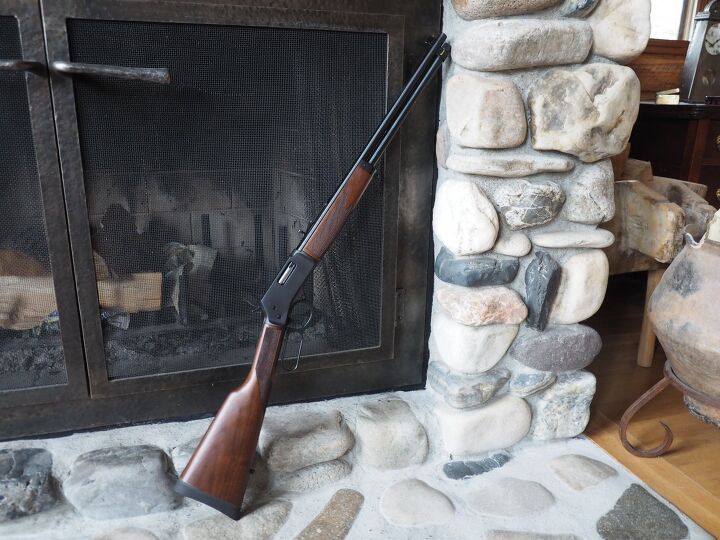Before we begin, let me set something straight:
The .327 Federal Magnum IS still around, and there are factory loads still available for it. While interest in the .327 has waxed and waned over the past decade, it sure is not as popular as the .357 magnum. For those of you who haven’t heard too much about the cartridge: Federal and Ruger introduced the cartridge in (I believe) 2008. The bullet diameter is in actuality .312″/7.92mm. (The only true .327″ diameter bullet I know is 8mm Lebel. If our readers know otherwise, let me know in the comments. Our Nathaniel F. notes that a few others, namely the 8x56R Steyr and 8x59RB Breda, come awfully close at .329″ respectively). An improvement over the 32 H&R Magnum, .327 Federal Magnum cases can take pressures of up to 45,000 psi. I’ve only handled transactions for .327’s in the past, (mostly Ruger revolvers), but never had the opportunity to fire one personally. I was, therefore, curious to try one out when the opportunity arose. This year, Henry USA provided that opportunity with one of their “Big Boy Steel” rifles in .327.
Echoes of the past:
Why is the .327 Federal round appropriate in a lever gun? The answer, I believe, can be found in the past use of the old .32-20 WCF round. Used as a small game round in the late 1800’s, some Winchester 73’s and 92’s were chambered in this caliber. Appropriately enough today, this particular Henry model in .327 is legal for SASS use in every category except for “classic cowboy”. This could be of utility for someone who has .32 caliber revolvers and wishes to use a same-caliber carbine for a very low-recoiling rifle and pistol setup. I suppose this Henry would also make for an OK small to medium, light skinned game/varmint carbine out to around 100 yards. I would not recommend it for the reliable harvesting of wild boar or deer, however. While muzzle energy and velocity isn’t extremely impressive from the .327 Federal Magnum round in revolvers, out of a 20″ barrel they get up to around 1900-2100 fps, with muzzle energies in the 700ft-lb(85gr)-1000ft-lb(100gr) range. Note: I was not able to independently verify this velocity data due to my chronograph needing a warranty repair.
Reinventing the “Steel”
As noted late last year by TFB’s Richard Johnson, Henry USA expanded their offerings to include this caliber. One came available for testing recently, and I was lucky enough to receive it for review. For help in sourcing ammunition for this review, Federal Premium Ammunition stepped up to the plate. They were kind enough to provide several boxes of both their 85gr Hydra-Shok JHP and their American Eagle 100gr SP loads.
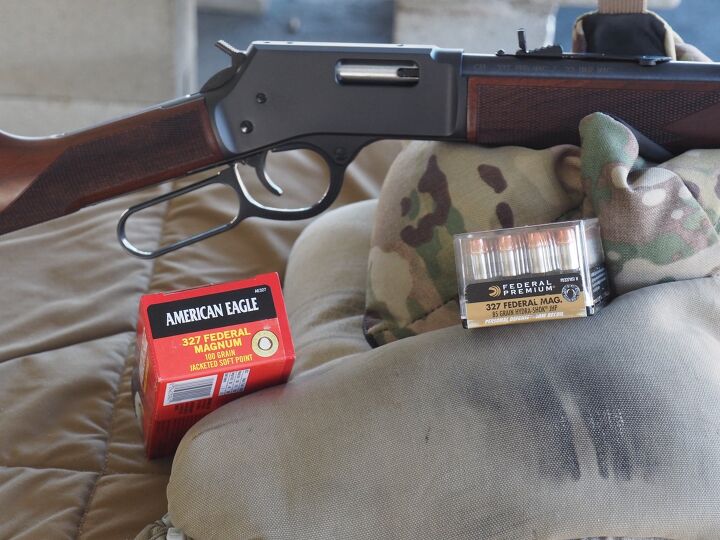
Thanks to Federal, I was able to have two factory loads to try out in this Henry
Specs:
Per Henry:
Model Number: H012M327Action Type: Lever ActionCaliber: .327 Fed Magnum/.32 H&R MagCapacity: 10 RoundsM.S.R. Price: $850.00
- Barrel: 20″, 1:16 twist
- Weight: 7lbs
First Impressions:
Upon first opening Henry’s standard cardboard shipping box, the rifle seemed to be of the same good quality one can expect from Henry. The checkering on the forearm and stock was nicely done, and there were no outward blemishes or machining marks. The rear sight is an adjustable buckhorn, with a front sight accentuated by an 8MOA brass plug. There is a half cock notch on the hammer. The bolt features a two-part firing pin for added safety as well. The “Steel” series guns also feature a forend cap rather than the barrel band found on the other series. The action and ejection port on the .327 is noticeably smaller than the .357 Henrys I have seen.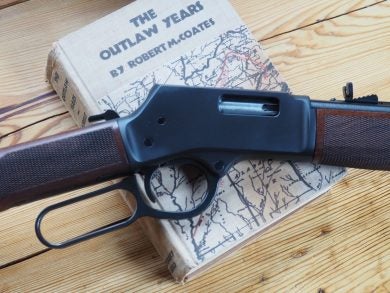
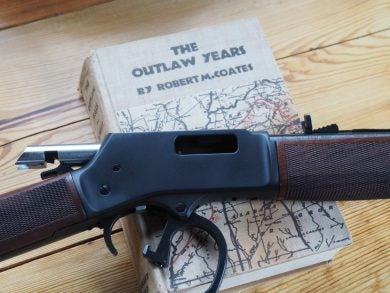
When I got around to trying the action and trigger, however, there were a few issues. Unlike the vast majority of around 100 of Henry’s rifles of all calibers that I have handled over the years (I used to work as a gunsmith and firearms retailer), both the movement of the lever and the trigger pull seemed a bit rough. The trigger pull measured at an average of 6.75lbs, higher than other Henrys I’ve measured as well. The break was gritty and uneven, suggesting that an interface between the trigger and hammer was not properly finished or polished. If one should encounter this issue as a consumer, I would suggest one get in touch with Henry USA. Being that their standard of quality is higher, I would imagine this would be a quickly remedied issue by their excellent and responsive customer service. Other than this one issue, overall fit and finish were excellent. A note for those of you with large hands: I did have the same issues with the lever loop that I had with their “Big Boy Silver” in .45 Colt, but a larger loop made by Tyler Gun Works is available from Henry for $70.
Range Time:
It was time to take the Henry to the range to put it through its paces. Though I didn’t have any .32 H&R magnum ammo available, I was able to shoot 5 shot groups at 50 yards with both .327 loads. Then, more importantly, I was able to ring some steel in rapid-fire competition type scenarios. For shooting groups, I used a sandbag front and rear rest. Even from the bench and under a corrugated metal roof, recoil and muzzle blast was nearly nonexistent-think .22lr level. Thought the receiver is drilled and tapped for optic use, I venture to guess that most potential customers will be using this rifle with the factory iron sights. 5 shot groups at 50 yards for both the 85gr JHP and 100gr SP loads were not stellar, at around an average of 2.75″ each. Not extreme accuracy, but certainly good enough for SASS matches or rabbit hunting. To be fair, I only had 2 loads to try out, and there could be any number of factory or handholds out there in .327 Magnum or .32 H&R that group better from this barrel.
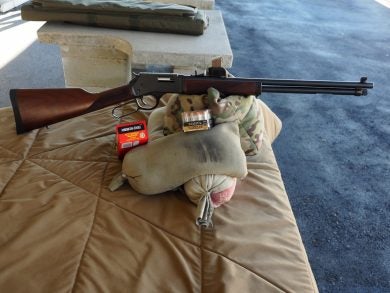
Set up for accuracy testing at 50 yards
Moving on to shooting steel plates ranging from 4-9″ in diameter at 25-40 yards away, the Henry was pretty fun. With a small “pop” and .22lr-like recoil, this rifle and cartridge had enough power to clear most of the steel target arrays reliably. While the cartridges slid smoothly once within the generously-sized loading window, loading the thin, diminutive .327 cartridges into the Henry’s magazine tube was a bit of a fumble-fest for my sausage fingers. Single loading through the ejection port was also somewhat difficult but could be easier if my fingers were smaller. I did not have a single failure to feed, fire, or eject in 110 rounds fired.
Overall Impressions:
Objectively, the Henry Big Boy Steel in .327 Federal Magnum is a reliable, low-recoiling rifle that is SASS legal and suitable for small game hunting at short to medium ranges. It is made in the USA by a company with a very good record for quality of product and their customer service. Accuracy with the two loads that I tested did not approach levels found in other caliber Henry rifles I have tested It should be noted that my sample size was admittedly small due to cartridge availability in this caliber and due to the fact that I do not handload this caliber either. It is also the only factory rifle that I know of chambered in .327 Federal Magnum.
Subjectively, I do believe this particular firearm would only be a good choice if:
- One already either already has a .327 Federal revolver and/or has the capacity to have a handloading setup for this cartridge.
- One is a SASS shooter looking for a low-recoiling pistol and carbine combination.
- One is very recoil-sensitive
Of the dozens of Henry rifles that I have seen go to customers over the years, I cannot recall hearing any complaints about them. I personally have had great experiences with their rifles. If one fits into the three categories above, by all means, check the H012M327 out. That being said, while the .327’s power is increased by the 20″ barrel, it is still a very niche cartridge with limited use. While the Henry “Big Boy Steel” line is a good platform, one would be better served in a more common caliber like .44 Mag, .45 Colt, or .357 Mag. More versatility, choices of factory loads and bullets, and power shouldn’t be something to pass up.
Pros:
- Extremely low recoil
- Good option for a SASS rifle
- Only production rifle currently made for the .327 Magnum
- Able to fire 32 H&R Magnum (and ostensibly .32 S&W Long)
Cons:
- Very limited factory cartridge selection (most distributors only had two loads available in this caliber when I checked)
- Limited performance of the cartridge
- I was unable to achieve a comparable level of accuracy to other Henry rifles with the two loads I tested
- .357 Mag or larger would be a far more versatile choice in this particular platform, at the same price and weight
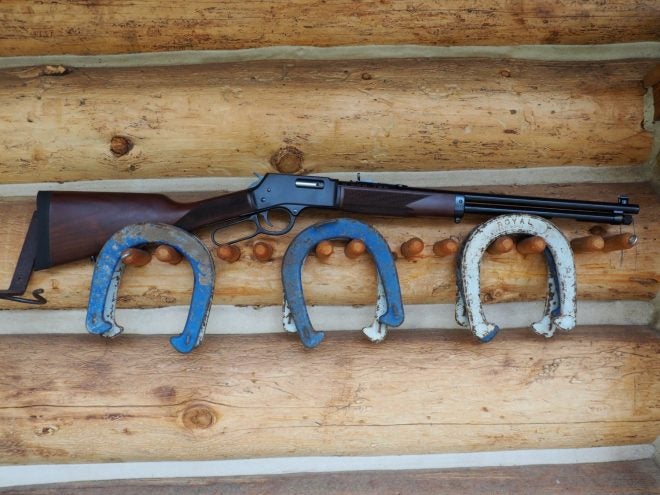
For more information, please visit Henry USA.
Many thanks to Federal Premium for providing ammunition.
Thanks to Hughston Shooting School for technical support.
 Your Privacy Choices
Your Privacy Choices
